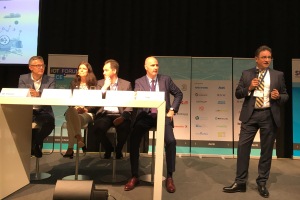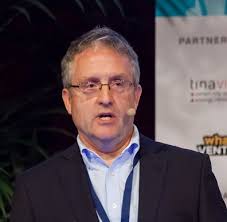EXCLUSIVE REPORT: Three leading European telcos admit at the 6th IoT Forum CE, that many customers are still not aware of the benefits of the Internet of Things (IoT). As one enterprise tells the C-Level operator panel, “You must show customers you understand their business, not just your own.”
Jeremy Cowan reports from a confessional Panel discussion in Vienna that attracted north of 400 delegates from 18 Central European countries.
In an inspirational Keynote address from Bela Virag, global head of Innovative Business Designs at analysts Arthur D. Little in Vienna, talked about the work of Australian incumbent network operator, Telstra who were invited to install 12 different camera angles at a UK football stadium, accessed by fans through their own app.
It soon became clear the service could be enhanced by increasing this to 40 cameras, each offering a real-time view of the match. Telstra then added the ability to order popcorn and drinks via the app, and today it can show you where the toilet queues are shortest, where to park when you arrive and much more.
So, Telstra have gone from selling connectivity to using their broader skills to innovate and launch brand new advertising-funded services for the connected consumer. Progress has often been so spectacular in business-to-business (B2B) Internet of Things (IoT) connections, that we can overlook the strides made in B2C (business to consumer) applications. Says Virag, “As IoT use cases evolve they start to require 5G. Operators are waiting for 5. Some customers are therefore building their own 5G in plants.”
Telcos may fail again
Clearly telcos still have a window of opportunity to capitalise on their customer knowledge and relations to bring new services enabled by 5th Generation mobile networks. But it’s a window that may be closing if the AD Little exec is to be believed – and I see no reason to doubt him.

He gives four examples of non-telecom players moving into the 5G space. Ericsson and Comau are reportedly working on a 5G-based smart manufacturing solution, Facebook is rolling out its Terragraph network in San Jose, California to gain gigabit speed throughput, Scania and Ericsson are improving the efficiency of “platooning” trucks in a semi-autonomous convoy, and NEC is developing a smfart video security system based on automated surveillance and alarms.
The diversification message has clearly got through to Hutchison Drei Austria, and its CEO Jan Trionow. He tells the conference, “Transport, logistics, and vending payments; all were early adoptions of M2M (machine-to-machine) communications. Now we’re evolving our capabilities including international components. We have medical partners, risk management partnerships, and data analytics are very important.
On the other hand, Stockholm-based Ingrid Wistrand, deputy CEO of Tele2 IoT, says: “Our strategy from 2012 still holds.” Tele2 will continue to do what they do best; providing connectivity and IoT-enabling technologies such as security and analytics.
Werner Kraus, SVP of Business & Wholesale at T-Mobile Austria comments: “We widen Austrian companies’ horizons through our international capabilities. Lots of companies in Austria don’t have the budget or the capacity to find a way through the jungle of competitive solutions. We guide them.”
Dr. Karim Taga, the panel moderator, asks Mladen Pejkovic, senior executive director of the food and beverage supplier, Atlantic Grupa, “So what promises to management did you make to bring (IoT solutions) to market?”
Pejkovic replies, “2015 was the trigger for our digital effort. IoT didn’t have a role in Phase 1, it was where to store and analyse data. Efficiency gains of up to 60% were possible, for example in managing retention (of staff) in HR. You can easily see the first staff that might be candidates to leave, and plan how to keep them.” And to fulfil customer expectations?
He adds, “With smart shelves we wanted information from customers such as their preference for pre-packaged goods versus drinks that the customer creates. If you sell vending (as a service) with the coffee machine included you get real time info on the amount of coffee cooked, but not sold. So you can have a discussion with the bar owner!” he added pointedly.
Failure to launch?
Almost inevitably, the question arises as to whether IoT has failed to meet growth projections, and there was a general acceptance that in some respects it has fallen short, so far. Tele2’s Ingrid Wistrand adds, “We’re not unhappy with fulfilment of our IoT growth. IoT is complex, you must work with lots of parties, that’s why we have a complex ecosystem of partners.

“By working together, we help customers improve time-to-market and to find the right partners. You must build in flexibility because the partners of today might not be best for you tomorrow.”
Jan Trionow of Hutchison 3 echoes some of this. He tells the 400-plus delegates, “We all have reason to be a little disappointed with where we are in IoT. Ericsson said it would be 20:20, with 20 billion connected devices by the year 2020. Well, we’re 18 months from that now.” Clearly, he doesn’t believe that the IoT sector is on track to meet those projections.
“Consumers’ discussions about data protection are sometimes more important to the consumer than the value (of IoT-enabled services) we can bring to them. LoRa (Long Range Wide Area Networks) and 5G discussions have dragged on for years too. Our own organisation needs to evolve mature skills to sell them IoT benefits.”
“I agree, we’re not there in technology, sales consultancy skills or sales digestion, and customers’ thought processes are not yet there,” says T-Mobile Austria’s Kraus. “Sometimes no one leads in a company to take ownership of this. If we want to come to the right numbers, it will never come from doing the same thing as before.”
“But Werner,” says Karim Taga, “you’re targeting the mass market, SMEs (small to medium-sized enterprises. How will you manage it?”
“Through technology and using prepared ecosystems with end-to-end delivery and end-to-end service level agreements,” Kraus replies. “But we must not be arrogant, we must listen to our customers about their state of mind. We mustn’t sell solution A, B or C because ‘it’s ideal for you’. It’s not one-size-fits-all customers. We must have a consultative sell.”
Speaking as an enterprise user or IoT solutions, Mladen Pejkovic of Atlantic Grupa takes much the same view. “It’d be wrong to conclude that customers are ready to pay extra for IoT-enabled solutions. The market needs convincing; customers are still not aware of the benefits. It needs ‘project thinking’ not just ‘product selling’. You must show customers you understand their business, not just your own.”
The author of this blog is Jeremy Cowan, editorial director of IoT Now & VanillaPlus
Comment on this article below or via Twitter: @VanillaPlus OR @jcvplus






